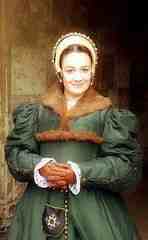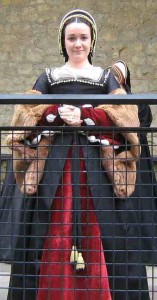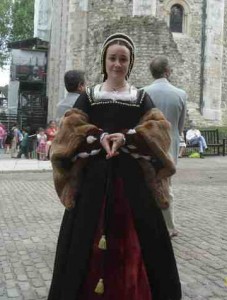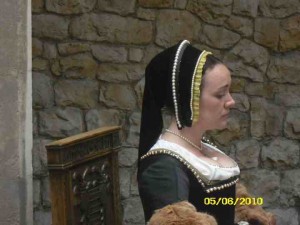Welcome to On the Tudor Trail Jo! Could you share with us a little about your background and the work you do with Past Pleasures?
Past Pleasures was founded in 1987 and its directors, Mark Wallis and Stephanie Selmayr are both experts in historical costume. The work is classed as historical interpretation and can be anything from massive 20 hander events, with horses, siege weapons and general organised chaos, to very small, intimate functions. We work mainly for Historic Royal Palaces, so you can find us at the Tower of London and Hampton Court Palace everyday that they are open, and also Dover Castle, Audley End House and other historic sites. It’s a massively growing field and seems to get bigger every year, as people appreciate the skill and the enjoyment of the team, as well as the stunning authenticity and beauty of the costumes.
I myself trained as an actor, as did many who work for the company, but had also loved history when I was growing up. When I was auditioning for drama school and later for acting work, I would sometimes find I had a few hours spare before I could get the off peak trains home, so I loved to wander around London, especially the city. However my favourite place to spend a few hours was sitting outside the Tower, eating my dinner and reading all about the history. For some reason, it always felt very peaceful, even amongst the tourists, so I loved going there. Getting to work there for the first time was one of the most exciting days in my life and I never get bored of it.
What sparked your interest in Tudor history?
I don’t honestly know, it wasn’t one specific thing, and I read huge amounts of other historical periods at work and enjoy those as well but I do keep coming back to those pesky Tudors. I think they are very familiar to most people, without necessarily even knowing why. I started to read up specifically on Henry et al during my drama school training because I desperately needed to start reading something different from acting texts and found I enjoyed it so much that I just kept going. A chance conversation one night with a friend put me in touch with PP and the rest, as the cliché says, is history.
I am sure that you have spent much time exploring the Tower of London and Hampton Court Palace. Perhaps you have even had access to areas normally restricted to the public. Could you share with us any ‘behind the scenes’ information?
We’re extraordinarily lucky with both where we work generally and often specifically with the rooms assigned to us. At the Tower of London, we reside in one of the medieval towers with a working medieval portcullis, not to mention a 14th century wall painting that rarely is seen by the public because its location and condition is so delicate. The rooms are a little cramped and the stairs are lethal in long skirts – but I love them and wouldn’t swap them for the world!
At Hampton Court, our rooms once belonged to the queens of England.
Genuinely, they belonged to Catherine of Aragon and they are where Jane Seymour gave birth to Edward and died. Even though they have mostly changed beyond all recognition, that is still pretty extraordinary. If nothing else, we have plenty of ghost stories to entertain ourselves with.
You have performed first-person interpretations of Anne Boleyn. What are the challenges and rewards of taking on such a persona?
I had wanted to play Anne since the moment I joined the company and I didn’t think I ever would, so when I was told I would be playing her for the Trial at the Tower, I will happily admit that I locked myself in the bathroom and burst into tears! Pathetic, I know but it was really important to me. The first rehearsal we had for the event last year was actually on the anniversary of the execution, so the whole cast took a quiet moment at the beginning of the night to walk past the execution memorial and read the flowers left by Anne’s modern day supporters, to quietly acknowledge everything that happened all those years ago. It was purely coincidental that it fell on that night but it felt right to begin like that.
Anne is a massively challenging part for anyone as she is one of the most complicated women in history. The problem with her is actually peoples’ perceptions of her vary so much. For some, she is a poor martyr, a victim of Henry’s lust and madness. For others, she is a manipulative shrew who got what was coming to her. Unfortunately, as so often in life, she was very human, warts and all (don’t get me started on goitres and six fingers!). I find her fascinating and I admire some things about her but if I had been alive in the Tudor period, I think my support would have been with Queen Catherine. Form an orderly line, if you want to lynch me!
The Trial of Anne at the Tower isn’t a new event, it’s happened many times before but we started adding the sequence of the execution itself, sword and everything, more recently. It sounds horrendous but it’s very stylised and I think it surprised people how well it worked and how moving it could be.
Every person in that team worked very hard to ensure there was nothing tacky or gratuitous about it. There is also a deep resonance from the fact we perform in the remains of the Great Hall, where Anne stood trial. We cannot perform the execution where it happened, on the north side of the White Tower because of logistical problems but, walking in her footsteps, you cannot help but feel that frisson down the spine.
However, there are massive challenges to playing in the Tower. It is one of the biggest tourist sites in the world and, on a busy summer weekend, can have 12 000 – 15 000 people through it, in a single day. As well as sheer numbers, there are constant distractions, noises, soldiers, helicopters, London Bridge opening… you name it, we have it! Trying to create one is basically a piece of site inspired theatre amongst all of that? Well, let’s just say it’s a challenge. One of my favourite memories was playing Lady Kingston the first time we did this version, with a lovely actress playing Anne. At the end of a very emotional scene where Anne has incriminated herself horribly, some foreign teenagers tried to disrupt the scene. Before I could intervene and politely ask them to leave, the audience, around 100 members of the public all turned around upon them and, in one voice, told them very decisively: SSSSSSSSHHHHH!!!!!!! Couldn’t have said it better myself! It’s a challenge but we take it up with much pleasure.
One final challenge is simply wearing a Tudor costume when it’s 30 degrees Centigrade outside. Fur, velvet, satin and extreme heat do not mix. In case you are ever tempted to ask a costumed person if they are “hot in that?”, save yourself the bother and just presume the answer is “Yes, very”.
How do you get into character?
I’m going to be really honest and say I hate questions like this because no matter what I say, I will sound like some idiot of an actor! So forgive me for this! It’s not difficult when you are dressed in a beautiful replica of a Tudor gown and sitting facing the White Tower that would have been one of the last things she saw. However, taking a quiet moment just to remember that all of these people were real is important and they deserve a voice, as fairly as we can give it.
Apart from Anne Boleyn, have you interpreted any other Tudor women?
Yes, amongst the many and varied characters we all regularly play, one of my favourites and most familiar is Katherine Willoughy, the Duchess of Suffolk.
She is a brilliant character, feisty, intelligent and a rare example of a woman with influence and wealth in her own right, not to mention great wit. I love her and am hoping to get to write a novel about her and her relationships within the court, as soon as I can get around to it. Until then, I’ll just enjoy playing her when I get the chance.
When researching the Tudor period what contemporary sources or biographies have you found particularly helpful?
We are very lucky to have a very talented research manager who provides massive amounts of information, including primary sources, for us. However, in terms of general reading, the best authors I use are Eric Ives for all things Anne related, Starkey’s works, Loades’s Tudor Court, Susan James’ Catherine Parr etc. We also look to Simon Thurley’s work on Hampton Court Palace for specific information there – I just wish he would write one for the Tower! I am also writing a radioplay about Thomas More and his daughter, so I am using John Guy’s wonderful book, A Daughter’s Love, for that. There are plenty of excellent historians out there, if you know what to look for but you do have to be careful. Learning to question if something is correct and not just accept it because it’s published is a very important ability to develop if you are interested in history.
Is there any one area of Tudor history that you are particularly interested in and draws your attention more than the others?
Yes, I am fascinated by the religious changes of the period and often teach a session at the Tower specifically about this, but also the period of change between Edward VI, Jane Grey and Mary’s reign. I find Mary I such a tragic figure; for me she is the epitome of wasted potential. Given the right marriage and circumstances, she could have been the famous queen in that family and yet she is so often forgotten as nothing more than that vile nickname, Bloody Mary. That’s one of the things I would most clout Henry around the head for!
Living in England, I am sure that you have visited many locations/buildings associated with the Tudors. Do you have a favourite?
Favourite other places: ooh loads! I have plenty I haven’t been to yet, so it’s hard to draw a definitive list. Growing up in the Midlands and Warwickshire, there are dozens of beautiful house and estates with plenty of history. Down the road from me are places like Baddesley Clinton, Packwood House and Charlecote Park not to mention Coughton Court, where news of the disastrous outcome of the Gunpowder Plot was broken to the wives and families of the plotters. You can crawl into a priest hole at Harvington Hall … so many other places, I never get bored of exploring them all and feel so lucky to live here and be able to see them so easily. It’s important that we look after our heritage; we are so blessed to have it.
What is one of your favourite Tudor moments or quotes?
My favourite Tudor quote is very simple: “These bloody days have broken my heart…Circa Regna Tonat” – About the throne, the thunder circles.
Thomas Wyatt knew what he was doing when he wrote that and I think it sums up just how awe-inspiring but also terrifying it must have been to be in the Tudor Court. It is also so easy to forget the grief that so many must have felt, on the whim on one man. As fascinating as I find it, the more I read, the happier I am that I live in the 21st century!



















Enjoyed the interview, Thnx 4 sharing.
Great interview! When we visited the Tower in 2009 we saw one of the re-enactments of Anne’s trial. It was very well done and quite movng.
As a volunteer at Historic Royal Palaces I have often seen Joanna – the Past Pleasures group are marvellous and really help to bring history to life for the public. I have often thought what a wonderful job they have combining history and drama – two great loves of mine.
Lovely interview! She has my dream job! Thanks!
I would love to chat electronically with a member of Past Pleasures, Ltd. about Living History Best Practices.
Bill Gwaltney
Formerly employed by the National Park Service, The Smithsonian Institution and The American Battle Monuments Commission.
gwaltney 479@yahoo.com
Thanks,
Bill Gwaltney